Investigating the Randomness of Passengers’ Seating Behavior in Suburban Trains
Abstract
1. Introduction
2. Material and Methods
2.1. Field Observation: Data Collection
2.2. Field Observation: Data Analysis
3. Results
3.1. Seating Preferences
3.2. The Seating Model: Algorithm and Test
4. Conclusions
Author Contributions
Funding
Acknowledgments
Conflicts of Interest
References
- Haghani, M.; Sarvi, M. Crowd behaviour and motion: Empirical methods. Transp. Res. Part B Methodol. 2018, 107, 253–294. [Google Scholar] [CrossRef]
- Hamacher, H.W.; Tjandra, S.A. Mathematical Modelling of Evacuation Problems: A State of Art; Technical report; Fraunhofer-Institut für Techno-und Wirtschaftsmathematik ITWM: Kaiserslautern, Germany, 2001. [Google Scholar]
- Dietrich, F.; Köster, G.; Seitz, M.; von Sivers, I. Bridging the gap: From cellular automata to differential equation models for pedestrian dynamics. J. Comput. Sci. 2014, 5, 841–846. [Google Scholar] [CrossRef]
- Seitz, M.J.; Dietrich, F.; Köster, G.; Bungartz, H.J. The superposition principle: A conceptual perspective on pedestrian stream simulations. Collective Dyn. 2016, 1, A2. [Google Scholar] [CrossRef]
- Klüpfel, H.; Meyer-König, T.; Wahle, J.; Schreckenberg, M. Microscopic simulation of evacuation processes on passenger ships. In Theory and Practical Issues on Cellular Automata; Bandini, S., Worsch, T., Eds.; Springer: London, UK, 2001; pp. 63–71. [Google Scholar]
- Kirchner, A.; Schadschneider, A. Simulation of evacuation processes using a bionics-inspired cellular automaton model for pedestrian dynamics. Phys. A Stat. Mech. Appl. 2002, 312, 260–276. [Google Scholar] [CrossRef]
- Pelechano, N.; Badler, N.I. Modeling crowd and trained leader behavior during building evacuation. IEEE Comput. Graph. Appl. 2006, 26, 80–86. [Google Scholar] [CrossRef] [PubMed]
- Alizadeh, R. A dynamic cellular automaton model for evacuation process with obstacles. Saf. Sci. 2011, 49, 315–323. [Google Scholar] [CrossRef]
- Gao, Z.; Qu, Y.; Li, X.; Long, J.; Huang, H.J. Simulating the dynamic escape process in large public places. Oper. Res. 2014, 62, 1344–1357. [Google Scholar] [CrossRef]
- Köster, G.; Hartmann, D.; Klein, W. Microscopic pedestrian simulations: From passenger exchange times to regional evacuation. In Operations Research Proceedings 2010: Selected Papers of the Annual International Conference of the German Operations Research Society; Hu, B., Morasch, K., Pickl, S., Siegle, M., Eds.; Springer: Berlin/Heidelberg, Germany, 2011; pp. 571–576. [Google Scholar]
- Von Sivers, I.; Templeton, A.; Künzner, F.; Köster, G.; Drury, J.; Philippides, A.; Neckel, T.; Bungartz, H.J. Modelling social identification and helping in evacuation simulation. Saf. Sci. 2016, 89, 288–300. [Google Scholar] [CrossRef]
- Bellomo, N.; Bellouquid, A. On multiscale models of pedestrian crowds from mesoscopic to macroscopic. Commun. Math. Sci. 2015, 13, 1649–1664. [Google Scholar] [CrossRef]
- Chraibi, M.; Seyfried, A.; Schadschneider, A. Generalized centrifugal-force model for pedestrian dynamics. Phys. Rev. E 2010, 82, 046111. [Google Scholar] [CrossRef]
- Arita, C.; Schadschneider, A. Density profiles of the exclusive queuing process. J. Stat. Mech. Theory Exp. 2012, 2012, P12004. [Google Scholar] [CrossRef][Green Version]
- Kim, I.; Galiza, R.; Ferreira, L. Modeling pedestrian queuing using micro-simulation. Transp. Res. Part A Policy Pract. 2013, 49, 232–240. [Google Scholar] [CrossRef]
- Köster, G.; Zönnchen, B. Queuing at bottlenecks using a dynamic floor field for navigation. Transp. Res. Procedia 2014, 2, 344–352. [Google Scholar] [CrossRef]
- Kneidl, A. How do people queue? A study of different queuing models. In Traffic and Granular Flow ’15; Springer: Cham, Switzerland, 2015. [Google Scholar]
- Köster, G.; Lehmberg, D.; Dietrich, F. Is slowing down enough to model movement on stairs? In Traffic and Granular Flow ’15; Knoop, V.L., Daamen, W., Eds.; Springer International Publishing: Nootdorp, The Netherlands, 2016; pp. 35–42. [Google Scholar]
- Seitz, M.J.; Bode, N.W.F.; Köster, G. How cognitive heuristics can explain social interactions in spatial movement. J. R. Soc. Interface 2016, 13, 20160439. [Google Scholar] [CrossRef] [PubMed]
- Chen, J.; Ma, J.; Lo, S.M. Geometric constraint based pedestrian movement model on stairways. Physcial A 2018, 505, 1212–1230. [Google Scholar] [CrossRef]
- Köster, G.; Lehmberg, D.; Kneidl, A. Walking on stairs: Experiment and model. Physical Review 2019. submitted. [Google Scholar]
- Curtis, S.; Best, A.; Manocha, D. Menge: A modular framework for simulating crowd movement. Collective Dyn. 2016. [Google Scholar] [CrossRef]
- Steiner, A.; Phillipp, M. Speeding up the airplane boarding process by using pre-boarding areas. In Proceedings of the Swiss Transport Research Conference, Ascona, Switzerland, 9–11 September 2009. [Google Scholar]
- Qiang, S.J.; Jia, B.; Xie, D.F.; Gao, Z.Y. Reducing airplane boarding time by accounting for passengers’ individual properties: A simulation based on cellular automaton. J. Air Transp. Manag. 2014, 40, 42–47. [Google Scholar] [CrossRef]
- Jaehn, F.; Neumann, S. Airplane boarding. Eur. J. Operat. Res. 2015, 244, 339–359. [Google Scholar] [CrossRef]
- Cis, P. Auslastungsgrad von Eisenbahnwagen in Abhängigkeit von Individuellem Fahrgastverhalten. Master’s Thesis, Technische Universität Wien, Wien, Austria, 2009. [Google Scholar]
- Plank, V. Dimensionierung von Gepäckablagen in Reisezügen. Master’s Thesis, Technische Universität Wien, Wien, Austria, 2008. [Google Scholar]
- Rüger, B.; Ostermann, N. Der Innenraum von Reisezugwagen—Gratwanderung zwischen Sinn und Effizienz. Eisenbahntechnische Rundschau (ETR) 2015, 3, 38–44. [Google Scholar]
- Tuna, D. Fahrgastwechselzeit im Personenfernverkehr. Master’s Thesis, Technische Universität Wien, Wien, Austria, 2008. [Google Scholar]
- Panzera, N. Die Haltezeit bei Hochrangigen, Innerstädtischen Verkehren—Einflussfaktoren und Optimierungspotenziale. Master’s Thesis, Fachhochschule St. Pölten GmbH, St. Pölten, Austria, 2014. [Google Scholar]
- Evans, G.W.; Wener, R.E. Crowding and personal space invasion on the train: Please don’t make me sit in the middle. J. Environ. Psychol. 2007, 27, 90–94. [Google Scholar] [CrossRef]
- Hirsch, L.; Thompson, K. I can sit but I’d rather stand: Commuter’s experience of crowdedness and fellow passenger behaviour in carriages on Australian metropolitan trains. In Proceedings of the 34th Australasian Transport Research Forum, ATRF 2011, Adelaide, Australia, 28–30 September 2014; pp. 1–15. [Google Scholar]
- Hall, E.T. The Hidden Dimension; Doubleday: New York, NY, USA, 1966. [Google Scholar]
- Trinkoff, A.M. Seating patterns on the Washington, DC Metro Rail System. Am. J. Public Health 1985, 75, 657–658. [Google Scholar] [CrossRef] [PubMed]
- Rüger, B.; Loibl, C. Präferenzen bei der Sitzplatzwahl in Fernreisezügen. Eisenbahntechnische Rundschau (ETR) 2010, 59, 774–777. [Google Scholar]
- Wardman, M.; Murphy, P. Passengers’ valuations of train seating layout, position and occupancy. Transp. Res. Part A Policy Pract. 2015, 74, 222–238. [Google Scholar] [CrossRef]
- Liu, X.; Song, W.; Fu, L.; Lv, W.; Fang, Z. Typical features of pedestrian spatial distribution in the inflow process. Phys. Lett. A 2016, 380, 1526–1534. [Google Scholar] [CrossRef]
- Liu, X.; Song, W.; Fu, L.; Fang, Z. Experimental study of pedestrian inflow in a room with a separate entrance and exit. Phys. A Stat. Mech. Appl. 2016, 442, 224–238. [Google Scholar] [CrossRef]
- Xiao, Y.; Gao, Z.; Qu, Y.; Li, X. A pedestrian flow model considering the impact of local density: Voronoi diagram based heuristics approach. Transp. Res. Part C Emerg. Technol. 2016, 68, 566–580. [Google Scholar] [CrossRef]
- Ezaki, T.; Ohtsuka, K.; Chraibi, M.; Boltes, M.; Yanagisawa, D.; Seyfried, A.; Schadschneider, A.; Nishinari, K. Inflow process of pedestrians to a confined space. Collect. Dyn. 2016. [Google Scholar] [CrossRef]
- Seitz, M.J.; Seer, S.; Klettner, S.; Köster, G.; Handel, O. How do we wait? Fundamentals, characteristics, and modeling implications. In Traffic and Granular Flow ’15; Knoop, V.L., Daamen, W., Eds.; Springer International Publishing: Nootdorp, The Netherlands, 2016; pp. 217–224. [Google Scholar] [CrossRef]
- Seitz, M.J.; Köster, G. Natural discretization of pedestrian movement in continuous space. Phys. Rev. E 2012, 86, 046108. [Google Scholar] [CrossRef] [PubMed]
- Von Sivers, I.; Köster, G. Dynamic stride length adaptation according to utility and personal space. Transp. Res. Part B Methodol. 2015, 74, 104–117. [Google Scholar] [CrossRef]
- Kleinmeier, B.; Zönnchen, B.; Gödel, M.; Köster, G. Vadere: An open-source simulation framework to promote interdisciplinary understanding. Collective Dyn. 2019. in review with (minor revision). [Google Scholar]
- Schöttl, J. Modelling Passengers’ Seating Behavior for Simulations of Pedestrian Dynamics. Master’s Thesis, Munich University of Applied Sciences, Munich, Germany, 2016. [Google Scholar]
- Wickham, H. Testthat: Get started with testing. R J. 2011, 3, 5–10. [Google Scholar] [CrossRef]
- Zönnchen, B.; Köster, G. A parallel generator for sparse unstructured meshes to solve the eikonal equation. J. Comput. Sci. 2019, 32, 141–147. [Google Scholar] [CrossRef]
- Seitz, M.J. Simulating Pedestrian Dynamics: Towards Natural Locomotion and Psychological Decision Making. Ph.D. Thesis, Technische Universität München, Munich, Germany, 2016. [Google Scholar]
- Dietrich, F.; Köster, G. Gradient navigation model for pedestrian dynamics. Phys. Rev. E 2014, 89, 062801. [Google Scholar] [CrossRef] [PubMed]
- Lubaś, R.; Porzycki, J.; Wąs, J.; Mycek, M. Validation and verification of CA-based pedestrian dynamics models. J. Cell. Autom. 2016, 11, 285–298. [Google Scholar]
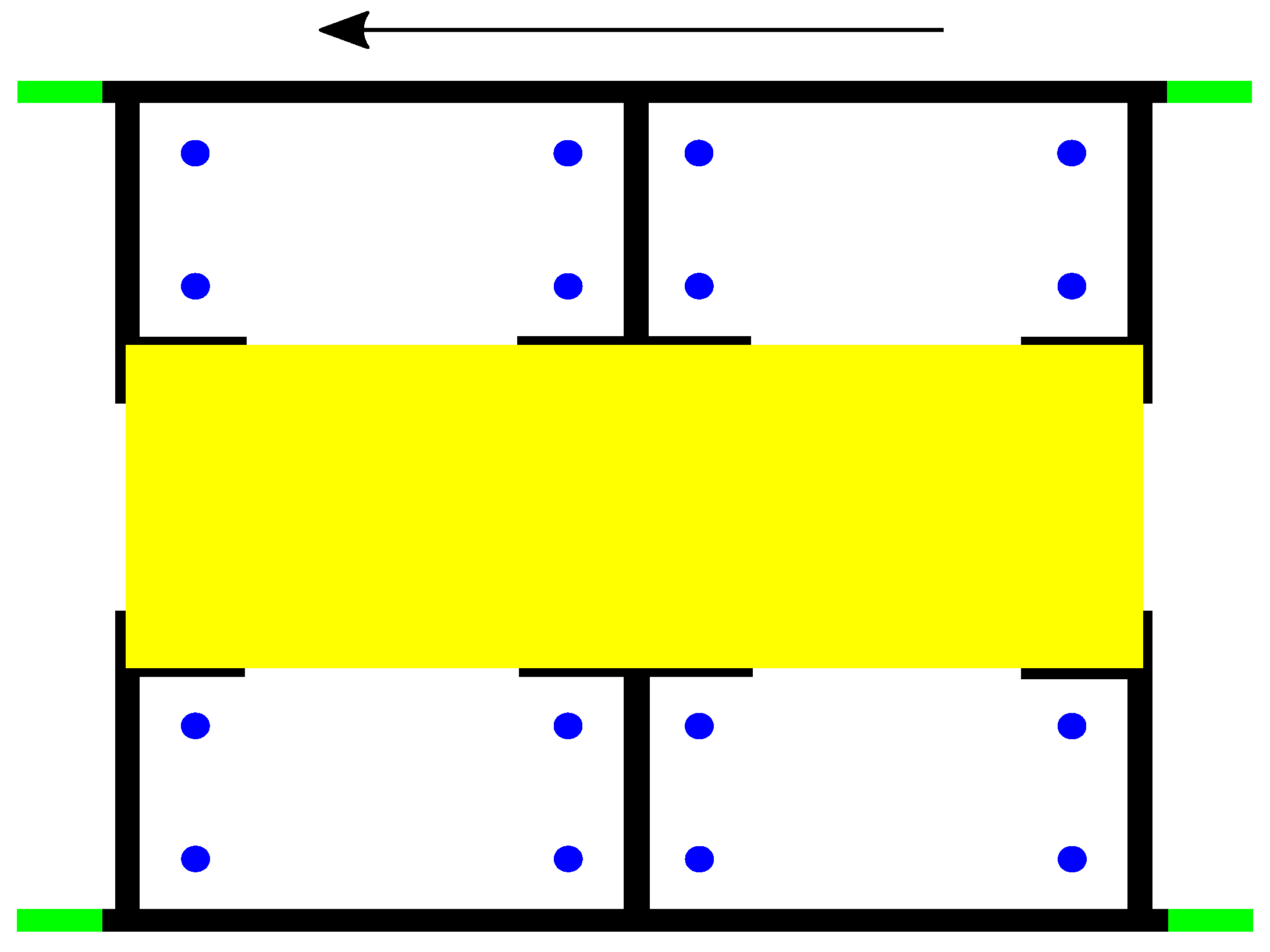
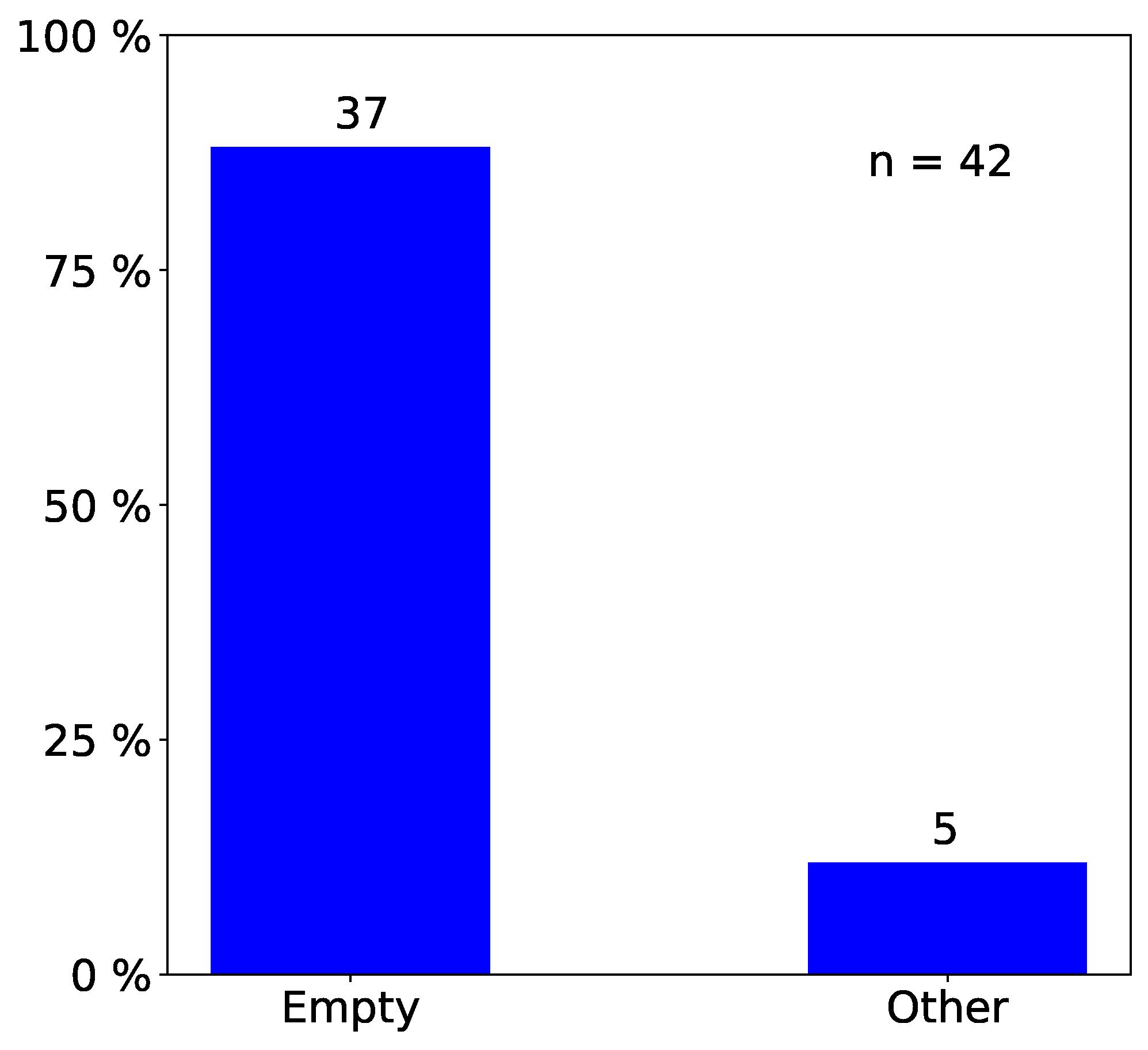
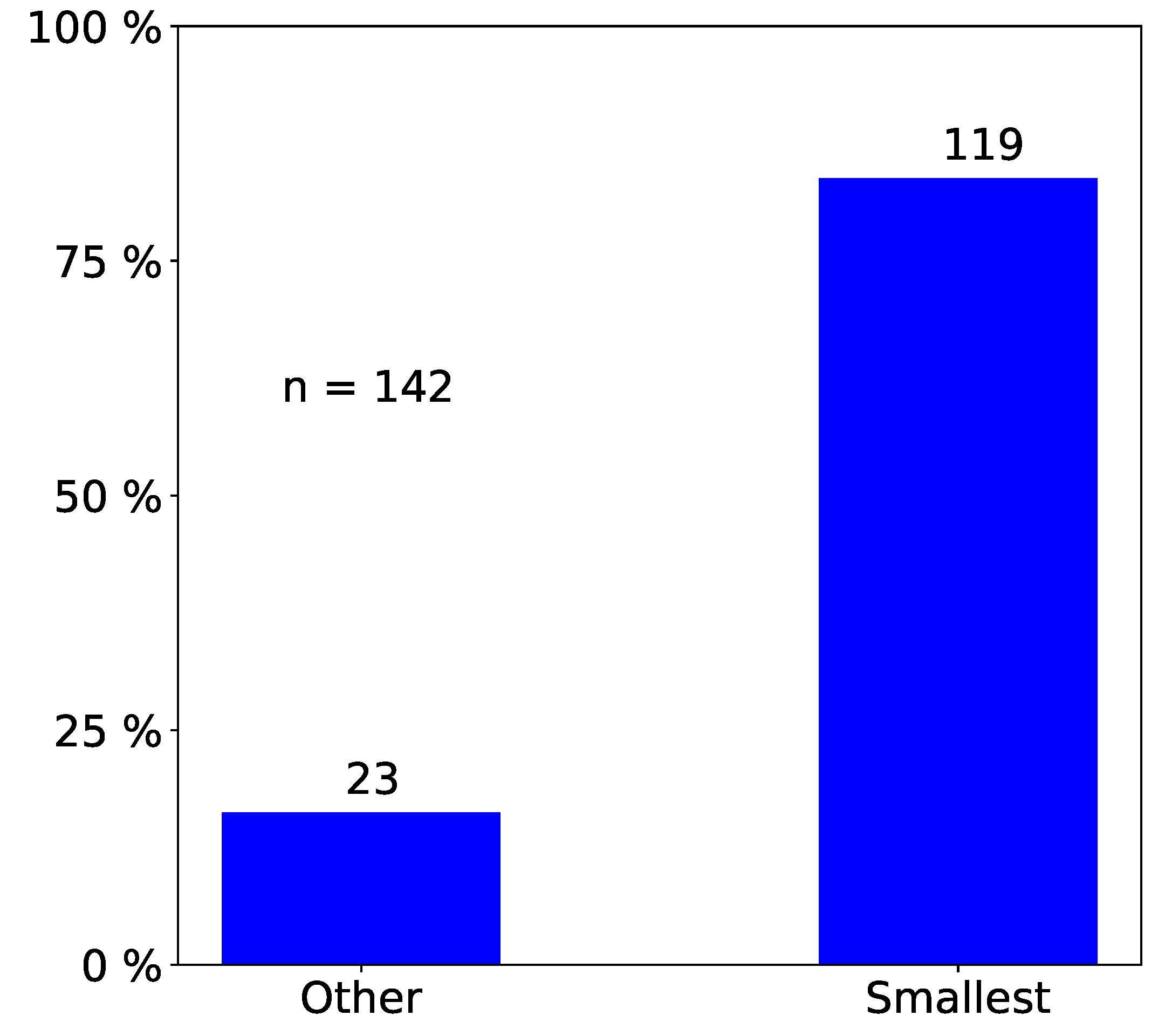
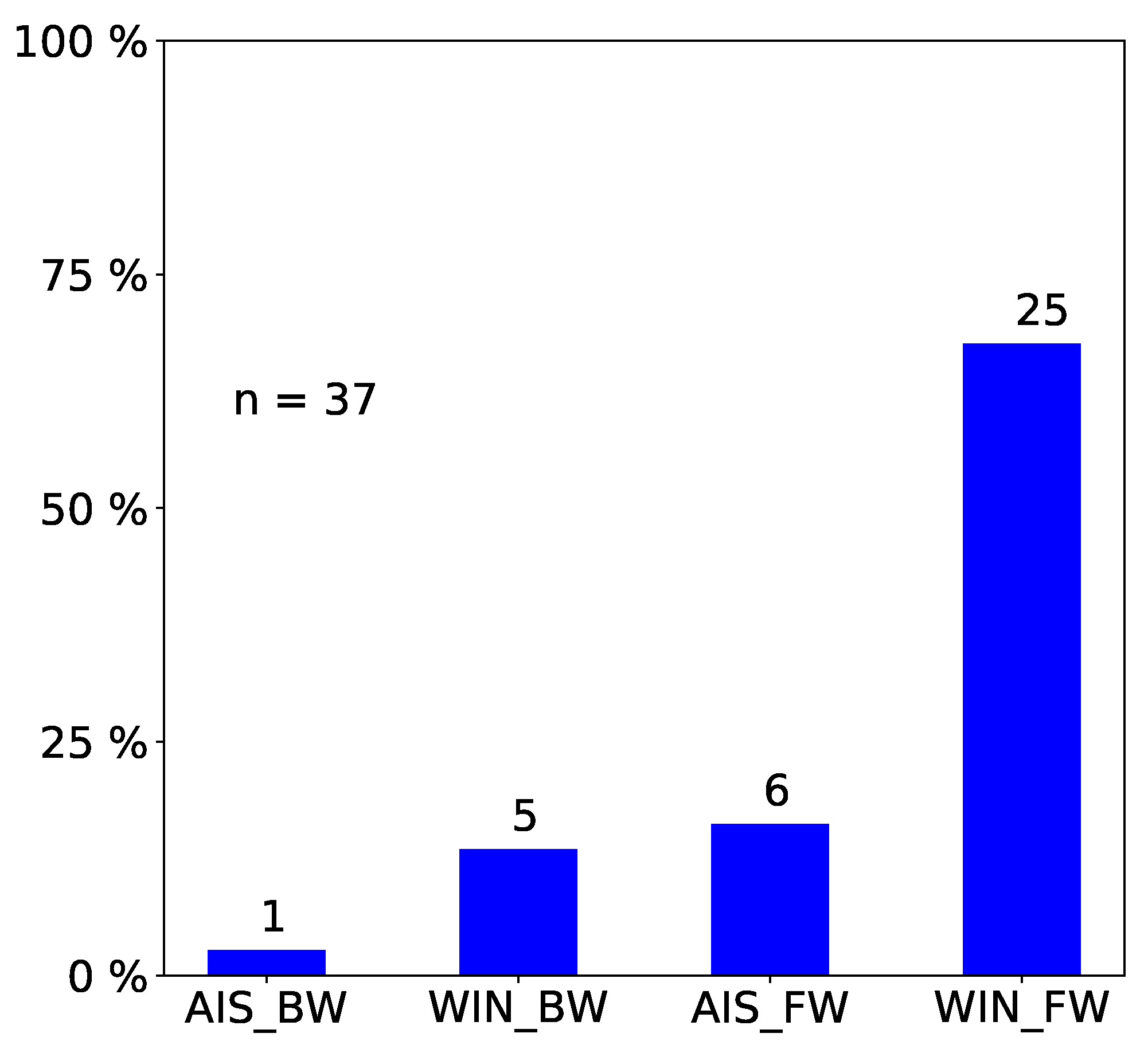
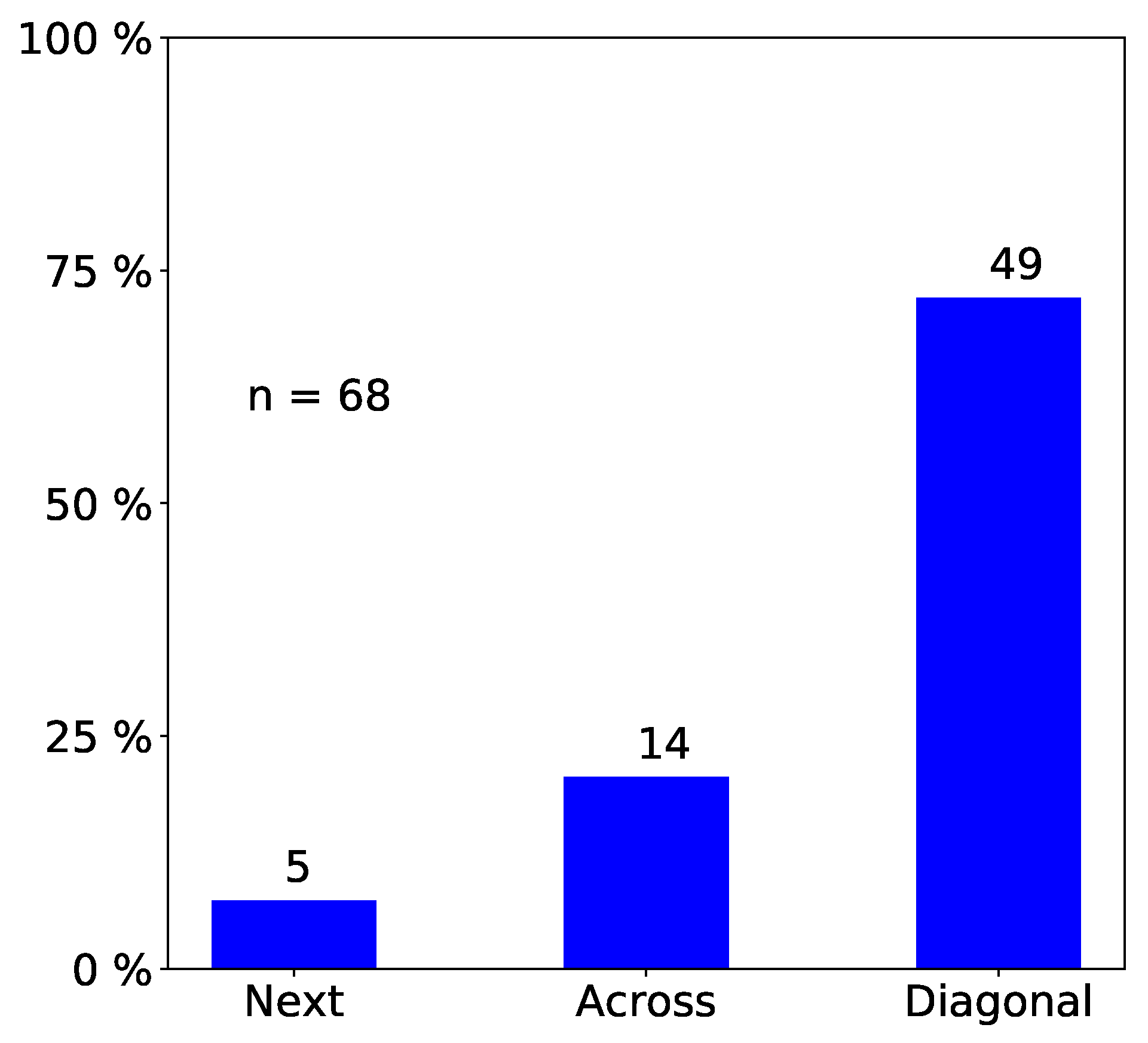

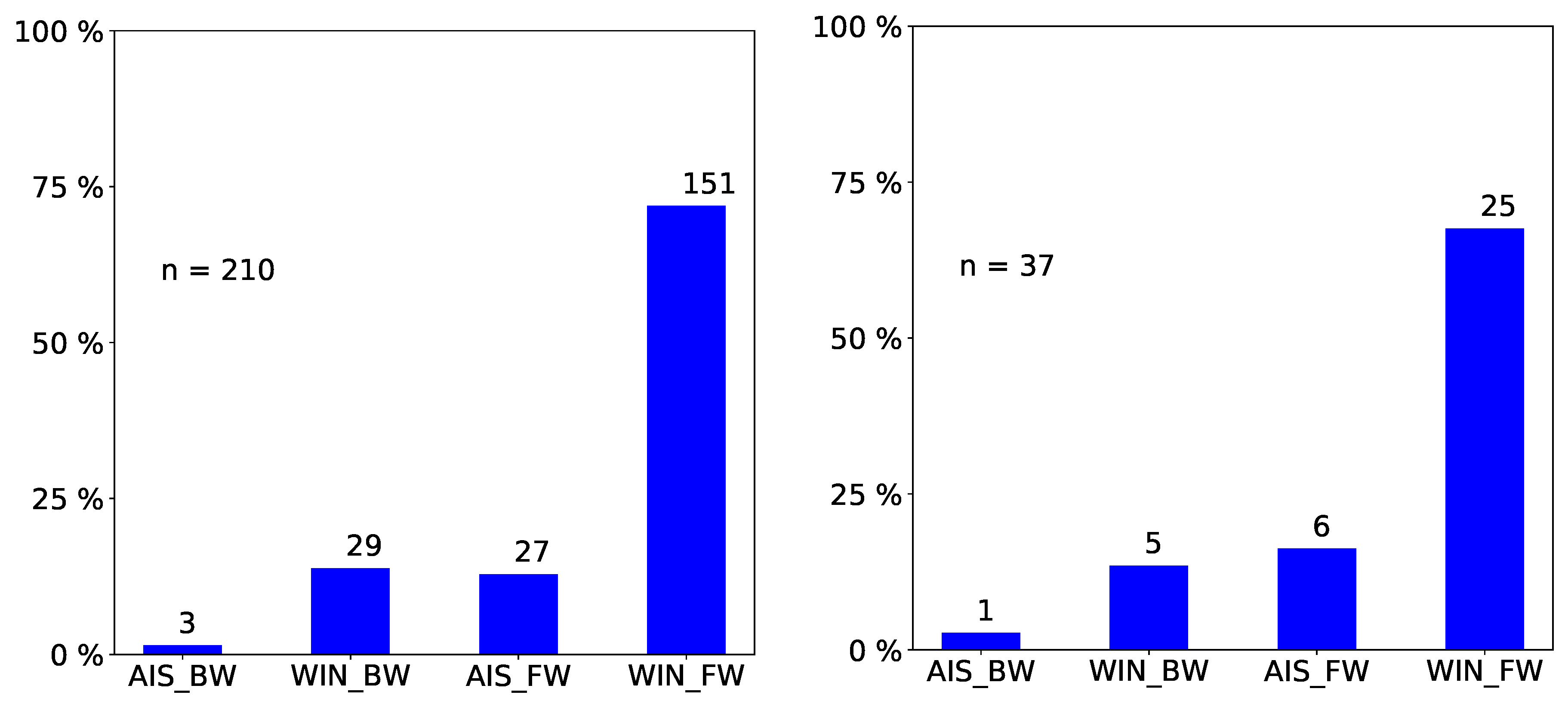
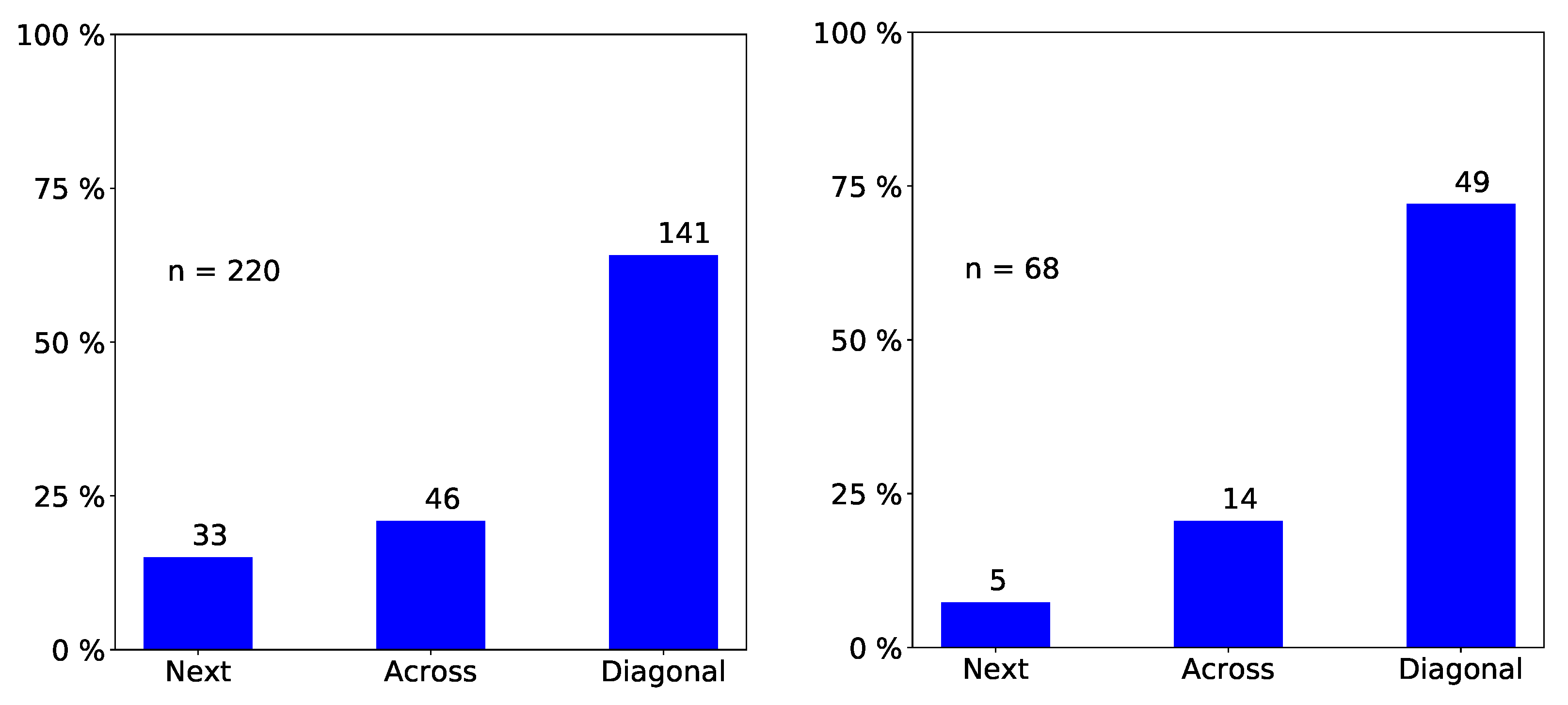
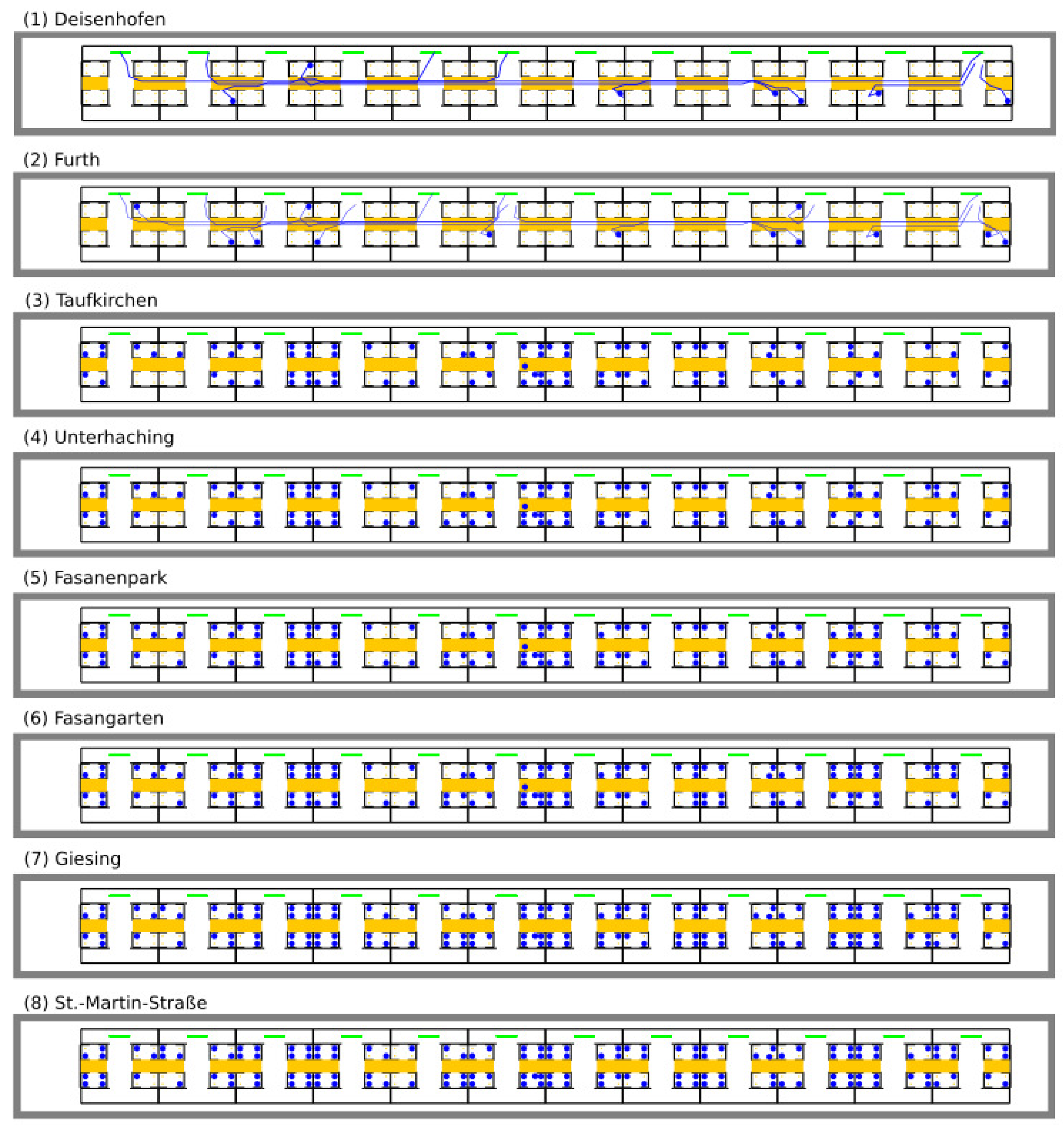
© 2019 by the authors. Licensee MDPI, Basel, Switzerland. This article is an open access article distributed under the terms and conditions of the Creative Commons Attribution (CC BY) license (http://creativecommons.org/licenses/by/4.0/).
Share and Cite
Schöttl, J.; Seitz, M.J.; Köster, G. Investigating the Randomness of Passengers’ Seating Behavior in Suburban Trains. Entropy 2019, 21, 600. https://doi.org/10.3390/e21060600
Schöttl J, Seitz MJ, Köster G. Investigating the Randomness of Passengers’ Seating Behavior in Suburban Trains. Entropy. 2019; 21(6):600. https://doi.org/10.3390/e21060600
Chicago/Turabian StyleSchöttl, Jakob, Michael J. Seitz, and Gerta Köster. 2019. "Investigating the Randomness of Passengers’ Seating Behavior in Suburban Trains" Entropy 21, no. 6: 600. https://doi.org/10.3390/e21060600
APA StyleSchöttl, J., Seitz, M. J., & Köster, G. (2019). Investigating the Randomness of Passengers’ Seating Behavior in Suburban Trains. Entropy, 21(6), 600. https://doi.org/10.3390/e21060600




